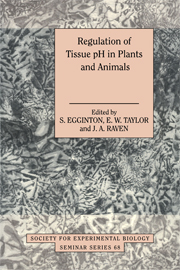Book contents
- Frontmatter
- Contents
- List of contributors
- Preface
- Measurement of intracellular pH: a comparison between ion-sensitive microelectrodes and fluorescent dyes
- pH-sensitive microelectrodes: how to use them in plant cells
- The use of nuclear magnetic resonance for examining pH in living systems
- Invasive studies of intracellular acid–base parameters: quantitative analyses during environmental and functional stress
- Lactate, H+ and ammonia transport and distribution in rainbow trout white muscle after exhaustive exercise
- Limiting factors for acid–base regulation in fish: branchial transfer capacity versus diffusive loss of acid–base relevant ions
- H+-mediated control of ion channels in guard cells of higher plants
- pH regulation of plants with CO2-concentrating mechanisms
- Intracellular pH regulation in plants under anoxia
- The role of turtle shell in acid–base buffering
- Acid–base regulation in crustaceans: the role of bicarbonate ions
- A novel role for the gut of seawater teleosts in acid–base balance
- pH and smooth muscle: regulation and functional effects
- Regulation of pH in vertebrate red blood cells
- Acid–base regulation in hibernation and aestivation
- Hepatic metabolism and pH in starvation and refeeding
- Back to basics: a plea for a fundamental reappraisal of the representation of acidity and basicity in biological solutions
- Index
Measurement of intracellular pH: a comparison between ion-sensitive microelectrodes and fluorescent dyes
Published online by Cambridge University Press: 22 August 2009
- Frontmatter
- Contents
- List of contributors
- Preface
- Measurement of intracellular pH: a comparison between ion-sensitive microelectrodes and fluorescent dyes
- pH-sensitive microelectrodes: how to use them in plant cells
- The use of nuclear magnetic resonance for examining pH in living systems
- Invasive studies of intracellular acid–base parameters: quantitative analyses during environmental and functional stress
- Lactate, H+ and ammonia transport and distribution in rainbow trout white muscle after exhaustive exercise
- Limiting factors for acid–base regulation in fish: branchial transfer capacity versus diffusive loss of acid–base relevant ions
- H+-mediated control of ion channels in guard cells of higher plants
- pH regulation of plants with CO2-concentrating mechanisms
- Intracellular pH regulation in plants under anoxia
- The role of turtle shell in acid–base buffering
- Acid–base regulation in crustaceans: the role of bicarbonate ions
- A novel role for the gut of seawater teleosts in acid–base balance
- pH and smooth muscle: regulation and functional effects
- Regulation of pH in vertebrate red blood cells
- Acid–base regulation in hibernation and aestivation
- Hepatic metabolism and pH in starvation and refeeding
- Back to basics: a plea for a fundamental reappraisal of the representation of acidity and basicity in biological solutions
- Index
Summary
Introduction
Intracellular pH (pHi) has been studied extensively for over a century using a wide range of techniques. These techniques have been subject to constant improvements to the extent that useful measurements can now be made in even the smallest of cells. This chapter outlines the development of ion-sensitive microelectrodes and dyes and highlights some of the difficulties and dangers of both of these methods. It then concentrates on some recent advances in our understanding of how fluorescent pH-sensitive dyes might best be used. Finally, a tabulated comparison between the two techniques is presented.
Historical perspective on pHi measurement
Although pHi changes had been observed much earlier, the first measurements of what could loosely be described as intracellular pH were made around 1910 using cell extracts and platinum/hydrogen electrodes (for a review see Caldwell, 1956). For example, in 1912 Michaelis and Davidoff measured the pH of blood and noted that red cell lysis caused a change in bulk pH. The technique of cell lysis was perhaps most suited to the measurement of pHi in non-nucleated erythrocytes where intracellular compartments did not complicate the measurements. At around the same time various workers were using naturally occurring pH indicators to visualise changes in pHi (e.g. Crozier, 1918). The problems associated with such indirect techniques were recognised very early on and the search for better methods led in three directions: distribution of weak acids and bases; smaller electrodes to allow direct measurement of pHi; and better indicators and techniques to load them into cells.
- Type
- Chapter
- Information
- Regulation of Tissue pH in Plants and AnimalsA Reappraisal of Current Techniques, pp. 1 - 18Publisher: Cambridge University PressPrint publication year: 1999
- 3
- Cited by



